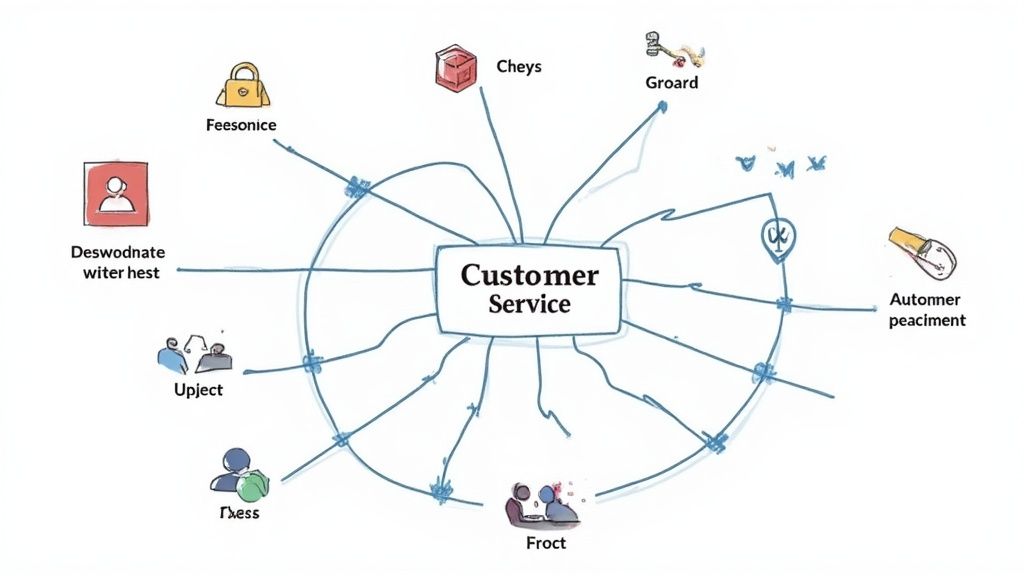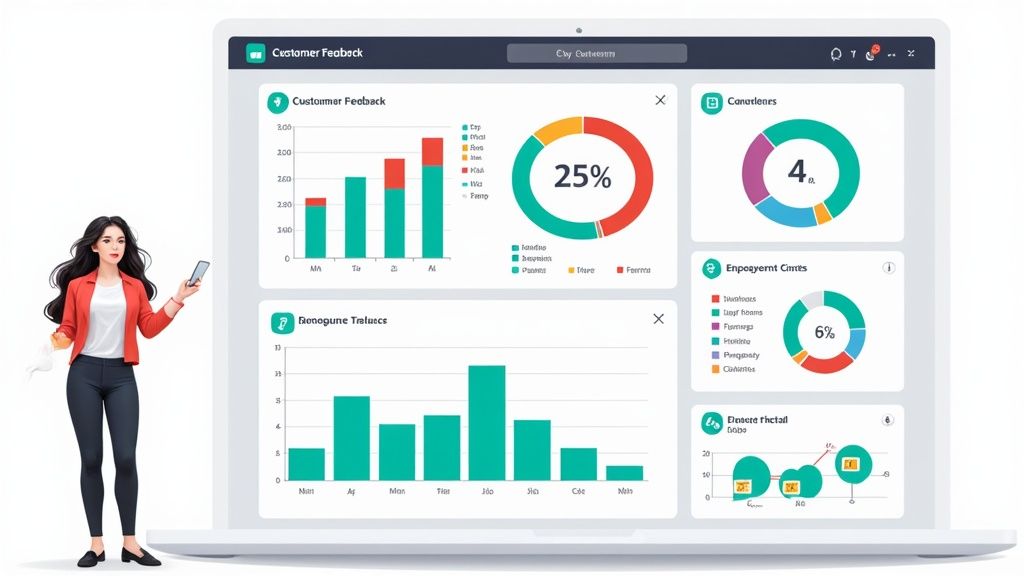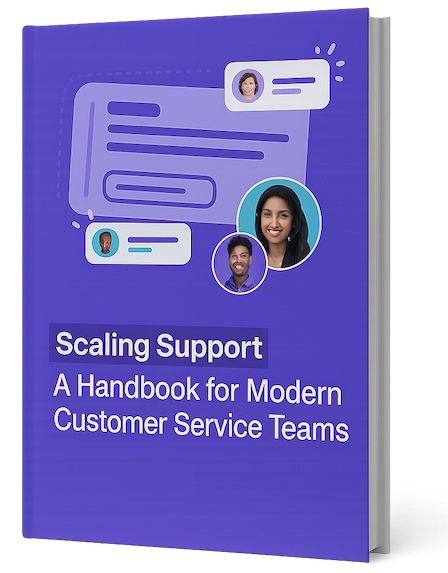Understanding The Automation Revolution in Customer Experience

Businesses are discovering new ways to serve customers through automation, as customer needs and behaviors continue to change. Rather than just adding new tools, companies are fundamentally rethinking how they connect with customers. The old manual approaches often can't keep up with what customers want and expect from service interactions.
Why Automation Is Becoming Essential
Today's customers want instant gratification – quick answers and immediate solutions when they need help. AI-powered chatbots make this possible by providing around-the-clock support, dramatically cutting response times compared to human-only teams. For instance, when a customer needs to reset their password at 3 AM, a chatbot can guide them through the process immediately, preventing frustration. This level of constant availability helps build customer loyalty and satisfaction.
The data shows this shift toward automation is accelerating rapidly. 80% of companies plan to use AI chatbots for customer service by 2025. In 2023, 75% of U.S. business owners reported that AI improved their customer experience through instant messaging capabilities. The growth is striking – 44% of companies expect to implement AI chatbots within two years, marking a 132% increase. You can find more details here: Learn more about AI in customer service statistics.
How Automation Impacts Service Delivery
Automation is making customer service more efficient and reliable. Rather than struggling with complex manual processes prone to delays and errors, support teams can now focus on building stronger customer relationships while automated systems handle routine tasks. For example, automated ticketing systems sort and prioritize incoming requests to ensure urgent issues get immediate attention.
This shift allows companies to handle growing customer demands without sacrificing service quality. By embracing automation thoughtfully, businesses can consistently meet customer needs, build trust through reliable service, and create positive experiences that keep customers coming back. The key is finding the right balance between automated efficiency and human connection.
Measuring The Real Impact of Customer Experience Automation
Moving to automated customer service takes careful planning to create meaningful change and get real business results. Here's what you need to know about measuring the actual performance and value of customer experience automation for your organization.
Identifying Key Performance Indicators
When evaluating automation's impact on your customer service, focus on these essential metrics:
- First Response Time: Track how fast customers get their initial reply – quicker responses lead to better satisfaction
- Resolution Time: Measure the total time to fully solve customer issues, as faster solutions create happier customers
- Customer Satisfaction (CSAT) Scores: Get direct feedback on how your automation affects customer happiness
- Repeat Purchase Rate: See if automated experiences drive more recurring business and customer loyalty
- Ticket-to-Order Ratio: Monitor if automation helps reduce support requests per order, indicating a smoother buying process
Together, these metrics give you clear visibility into automation's effect on both support efficiency and business growth.
Learning From Success Stories
Looking at real customer service automation examples shows what's possible. For instance, companies using Gorgias have seen major improvements in key areas:
- 37% faster first response times
- 52% quicker issue resolution
- 36% more repeat purchases
- 27% fewer tickets per order
These gains come from smart automation choices like optimizing workflows, personalizing messages, and routing inquiries efficiently. Examining how other companies achieve these results provides practical ideas for your own automation strategy.
Building a Compelling Business Case
Making a strong case for automation requires focusing on metrics that matter to your business and stakeholders. Start by identifying which KPIs best demonstrate automation's value for your specific goals and customer needs. Then gather data showing clear improvements in those areas. This helps you get buy-in and support for automation projects while ensuring you're tracking progress toward real business outcomes.
Creating The Perfect Balance Between Automation and Human Touch

Finding the right blend of automation and human interaction directly impacts customer satisfaction. While technology can handle basic requests quickly, there are moments when personal attention makes all the difference. Let's explore how to strike this balance effectively.
Understanding When Automation Shines
AI-powered chatbots excel at managing high-volume, routine tasks like password resets, order tracking, and FAQs. By handling these predictable requests automatically, support teams can focus their energy on complex issues that need careful attention. This setup allows for round-the-clock support while keeping costs reasonable. For customers, it means getting quick answers to simple questions any time of day.
Recognizing the Importance of Human Interaction
Sometimes customers need more than an automated response. Complex technical problems and emotionally charged situations call for human empathy and creative problem-solving. Experienced support agents can pick up on subtle cues and adapt their approach based on each unique situation. The numbers back this up – 90% of customers still prefer speaking with humans over chatbots. In fact, satisfaction ratings (NPS scores) are 72 points higher when customers work with human agents versus automated systems. Learn more about these trends here: Explore AI's role in customer service.
Building a Hybrid Service Model
Smart companies use hybrid service models that combine automation and human support. This means directing straightforward questions to automated systems while smoothly connecting customers with human agents for complex issues. The goal is making every interaction efficient while ensuring customers get the right level of help for their specific needs.
Maintaining a Consistent Brand Voice
Whether a customer chats with a bot or speaks to an agent, the experience should feel unified. This happens through careful training of both AI systems and human staff to follow clear communication guidelines. When everyone stays on-brand, it builds customer confidence and trust.
Practical Frameworks for Finding the Right Mix
To determine your ideal automation balance, start by understanding your customers and business goals. Here's what to consider:
- Customer Segmentation: Group customers based on their needs and comfort with automated support
- Interaction Mapping: Chart common customer journeys to spot where automation helps and where human touch is essential
- Decision Trees: Create clear guidelines for routing inquiries based on complexity and urgency
By putting these strategies into practice, you can build a support system that's both efficient and personal, leading to happier customers who stick around longer.
Implementing Successful Customer Experience Automation
Making the switch to automated customer service requires careful planning and execution. This section outlines practical steps to help you implement customer experience automation effectively, from evaluating your needs to optimizing performance over time.
Assessing Your Automation Readiness
Before making any changes, take time to understand where your organization stands today. Here are key areas to evaluate:
- Current Customer Service Processes: Document your existing workflows and identify bottlenecks. For instance, do certain types of questions repeatedly overwhelm your support agents?
- Technology Infrastructure: Check if your current systems can work with new automation tools. Does your CRM have the right integration capabilities?
- Team Capabilities: Get a clear picture of your team's technical skills and comfort level. What training might they need to use new automation tools effectively?
Taking stock of these elements helps create a solid foundation and prevents issues during implementation.
Selecting the Right Automation Tools
The tools you choose will directly impact your success with automation customer experience. Focus on finding solutions that match your specific needs:
- Seamless Integrations: Look for tools that work smoothly with your key platforms. For example, SupportMan connects Intercom ratings to Slack for instant feedback monitoring.
- Scalability: Pick tools that can grow alongside your business and handle increasing customer volume.
- User-Friendliness: Choose platforms your team can learn quickly to speed up adoption.
When you select the right tools, your team can provide better service while working more efficiently.
Implementing and Training Your Team
Success with automation goes beyond installing new software – it requires thoughtful change management:
- Phased Rollout: Start small with a pilot program before expanding to your full operation.
- Comprehensive Training: Give your team thorough instruction on new tools and processes.
- Ongoing Support: Provide help resources and regular check-ins during the transition.
This measured approach helps your team adapt while maintaining quality service.
Managing Change and Optimizing Performance
Keep a close eye on results after launch and make improvements:
- Performance Monitoring: Track key metrics like response times and satisfaction scores. Tools like SupportMan help by providing real-time customer feedback.
- Continuous Improvement: Review and adjust your automated workflows regularly based on results.
- Feedback Collection: Get input from both customers and support staff to identify what's working and what needs adjustment.
By staying focused on measurement and refinement, you can ensure your automation customer experience strategy delivers lasting benefits to your business.
Emerging Trends Shaping The Future of Customer Experience Automation

The field of customer experience automation continues to grow and adapt. Businesses need to keep up with rapid changes in AI, machine learning, and new ways to connect different tools and systems. In this section, we'll explore key trends that are changing how companies provide customer service.
The Rise of Hyper-Personalization
Hyper-personalization has become essential for modern customer service. This approach goes far beyond using a customer's name – it uses data and AI to build detailed profiles based on past interactions, preferences, and likely future needs. For example, an online store might adjust its entire layout and messaging for each visitor based on how they like to shop.
AI-Powered Proactive Support
Companies are now using AI to solve problems before customers even report them. Picture a software platform that spots when someone is having trouble with a feature and automatically offers help or connects them with support staff. This forward-thinking approach helps keep customers happy while reducing the number of support tickets teams need to handle.
Seamless Omnichannel Integration
Customers expect the same great service no matter how they reach out. Omnichannel integration means someone can start talking to a chatbot on your website, switch to a phone call with an agent, and never have to repeat themselves. When all these touchpoints work together smoothly, it builds trust and keeps customers coming back.
The Growing Importance of Voice AI
More customers now feel comfortable using voice commands to interact with businesses. Virtual assistants and voice-enabled chatbots are becoming standard features. Companies need to make sure their automated systems can handle voice interactions clearly and efficiently. Soon, customers might expect to handle everything from billing questions to product support just by speaking to their smart devices.
Practical Strategies for Staying Ahead
Smart businesses are preparing for these changes by:
- Using advanced analytics to better understand their customers
- Testing new AI tools and platforms
- Choosing flexible automation solutions that can grow with them
- Building continuous learning into their support teams' routines
To stay competitive, businesses should focus on these strategies while staying open to new approaches. Tools like SupportMan help by connecting real-time customer feedback from Intercom to Slack, making it easier to spot trends and respond quickly to changing customer needs.
Essential Takeaways and Strategic Action Steps

Let's explore concrete steps to successfully implement automation customer experience in your business. Whether you're just starting out or looking to improve your existing automation, these practical insights will help you achieve measurable results.
Key Takeaways for Automation Success
- Smart Balance of Human and Tech: Use automation for routine tasks like password resets and FAQ responses, while keeping your team focused on complex issues that need a personal touch. This gives you the best of both worlds – quick responses for simple queries and quality care for tricky problems.
- Start Small, Scale Smart: Pick specific areas where automation can make the biggest difference right away. Focus first on common, repetitive tasks that take up a lot of your team's time. This focused approach helps your team adapt smoothly while delivering quick wins.
- Let Data Guide You: Keep track of key metrics like response times and customer satisfaction scores. Use this information, along with customer feedback, to spot what's working and what needs adjustment. Regular data reviews help you make smart decisions about improving your automation setup.
- Keep Fine-Tuning: Customer needs and tech capabilities change often. Make it a habit to check how well your automated processes are working and adjust them based on performance data and customer input. Small, regular improvements add up to big gains over time.
Strategic Action Steps to Implement Now
Here's how to put automation customer experience into practice:
- Map Your Current Process: Write down exactly how you handle customer service now. Note where things slow down or get stuck. This clear picture helps you pick the right places to add automation.
- Set Clear Goals: Create specific, measurable targets for your automation projects. For example: "Cut first response time by 20% in three months." These clear goals help you track real progress.
- Choose Tools Wisely: Pick automation tools that work well with what you already use and can grow with your business. Look for user-friendly options that your team can learn quickly.
- Prepare Your Team: Give thorough training on new tools and check in regularly to help everyone succeed. The better your team understands the tools, the more value you'll get from them.
- Watch and Improve: Keep checking your key metrics and asking for feedback from customers and staff. Use what you learn to make your automation work better over time.
Measuring Your Progress
Track these key metrics to see how well your automation customer experience strategy is working:
| Metric | Target |
|---|---|
| First Response Time | Reduction of at least 25% |
| Resolution Time | Decrease by 30% or more |
| Customer Satisfaction (CSAT) | Increase of at least 10 points |
| Repeat Purchase Rate | Growth of 15% or higher |
| Ticket-to-Order Ratio | Aim for a decrease of 20% |
By following these practical steps and tracking your progress, you'll build an effective automated customer service system that works better for both your team and your customers.
Ready to make your customer support more efficient? Start your free trial of SupportMan today! SupportMan brings Intercom ratings straight to Slack, helping your team stay on top of customer feedback and improve service quality.


